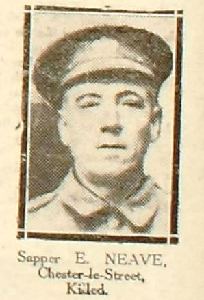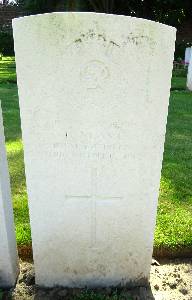
Chester Chronicle Friday 22/10/1915

Photo: Len
Medal Index Card
Newcastle Journal Saturday 09/10/1915
170th Tunnelling Coy, Appendix 'B'
Ezra Neave was born in June 1876 at South Burns in Chester-le-Street, the eldest son of eight children to James, [born 1846, Walcott, Norfolk], a Gas Stoker with his wife Maria, [born 1846, Witton, Norfolk], they moved to the North East after 1871.
The children were all born in Chester-le-Street, Madeline born 1872, John born 1880, Sophia born 1882, Elizabeth born 1884, Fannie born 1885, Annie born 1887.
In 1891 the family were residing at Edward Square in Chester-le-Street.
In 1901 Ezra and his wife Rachael, who married 28th December 1895, at Lanchester, were now residing at William Street, Chester-le-Street. Rachael [nee Davison], was born at Lanchester, in 1879, daughter of Thomas and Jane Davidson, both from Chester-le-Street.
Ezra and Rachael had eight children, Rachael born 1897 but died before 1911, George born 1898, Barbara born 1900, Norah born 26th September 1902, Millicent born 26th January 1904, John William born 19th October 1906, Mabel born 22nd July 1909 and Norman born 22nd January 1912.
In 1911 the family were residing at 31 Park View, South Pelaw, Chester-le-Street. Ezra worked at South Pelaw Pit as a deputy overman, Underground. He started his employment at South Pelaw Colliery around 1901.
He was a member of the Osborne [Working Man's] Club in Chester-le Street. Ezra attested on the 1st June 1915 at Chester-le-Street where he was given a medical test. He was 5 feet 11 inches tall, weight 168 lbs, he then enlisted at London, at 3 Central Buildings, Westminster, [which was then the Tunnelling Depot, hastily formed by Major J. Norton-Griffiths], on the 8th June 1915. Service number 102462 into the Royal Engineers. His address stated then was 9 Elizabeth Street, Chester-le-Street.
He then signed for 51 items from the New Clothing Store R.E. Depot. This was a list of everything that a soldier would need.
He was sent to France on the 11th June 1915.
He was transferred from 'N' [11] Company into the 170th Tunnelling Company, Royal Engineers. He was paid 2s 2d a day as he was a qualified Tunneller's Mate. On the 28th July he was re-mustered as a sapper, and was given a certificate acknowledging this fact. [The average infantry man rate was 1s and 3d a day].
He joined the 170th Tunnelling Company on the 15th June 1915 in the Field. Ezra became an official Tunneller on the 23rd July 1915, after receiving a reference from the Manager of the South Pelaw Colliery, Mr Gilchrist.
In a letter dated 4th June 1915, on South Pelaw Colliery letter heading under the heading Special Mining Recruits Ezra Neave, 39 years, 31 Park View, South Pelaw, Chester-le-Street.
" I have known Neave for fifteen years. He has been employed for over ten years at this Colliery as an underground official (deputy overman) and has acted as Back overman in the temporary absence of the permanent official. He is present employed as deputy overman and also as timber drawer. He is one of the best of our underground officials and a good man at getting work done and controlling the men and boys in his charge". Signed: George G. Gilchrist. Manager.
170th Tunnelling Company was the first Royal Engineer Tunnelling company to be formed, it was on Saturday the 19th February 1915, that the company was formed at the RE HQ at Chatham. 20 men were selected from Norton-Griffiths own company who before the war were working on the sewers and drainage systems at London and Manchester.
Also the 170th Tunnelling company was the first company to successfully defeat the geology of running sand to reach the dry clay underneath. 6th May 1915, by Lieutenant J. A. Leeming and his section.
There was a circular sent out by the War Office to recruit people for the new Tunnelling Companies.
The 170th Tunnelling Company was formed in February 1915, and initially attached to 11th Field Company, Royal Engineers. It was formed with a nucleus of civilian sewer-workers from Manchester and with miners withdrawn from a number of infantry battalions. It was rushed to Givenchy for operations to counter enemy activity and was relieved by 176th Tunnelling Company in June 1915. It was then employed under the command of 2nd Division on operations near Cuinchy and the Brickstacks in Summer 1915. The Company blew two mines at the Hohenzollern Redoubt in the opening of the Battle of Loos. They remained in this very active area for a considerable time. In April 1918 troops of the Company fought a large fire in Bethune.
Source: Holyhead War Memorial.
In the opening of the Battle of Loos (25th September – 14th October 1915), the unit blew two mines at the Hohenzollern Redoubt. 170th Tunnelling Company remained in this very active area for a considerable time, until 251st Tunnelling Company took over in October 1915. Ezra was killed by a mine explosion by the Germans on Saturday 2nd October 1915 under Jerusalem Hill, at approximately 7.50pm, [diary entry reads 7.30pm] which was halfway between the right T of no 5 and left of no 8. [Tunnels]. The German mine explosion was located under the old crater in front of Sap 11, which resulted in the right branch of 5 to bend, and left branch of 8. The four men working in no 8 were buried, the rest of the men in no 5 in shock. Infantry Losses reported to be about 5 killed. War Diary entry reads s follows: "Right T of no 5 closed in beyond the turn, and left T of no 8 partially closed for 20' [feet] and remainder completely closed. Have started cleaning out in no 5 and will start in no 8", G C Daniels Lieut R.E.
Four men were killed, 4 men wounded and 4 to hospital with shock, another 4 miners to hospital the following day.
No 5 tunnel was located in Hanover Street at map ref A 15 D, 3. 2. it was started on the 11th June 1915, and it was 103 feet long at a depth of 20 feet, Forward branch, right branch started on the 29th June 1915, 79 feet long at a depth of 20 feet, completed by the 15th October 1915.
His personal effects were returned to his wife and consisted of Identity Disc, Note Book, Pocket Case, Photos etc. She signed for them on the 10th February 1916. Rachel his wife was awarded a pension of 27 shillings a week for her and five children, which took effect from the 17th April 1916.
With Thanks to : Jeremy Banning
Ezra Neave is remembered at Chester-le-Street on C105.01 C105.12, C105.15, C105.31 and C105.40
He is also remembered on the Where The Tunnellers Rest Memorial page.
The Tunnellers Memorial
BBC Site
Tunnelling Companies of WW1
The CWGC entry for Sapper Neave

